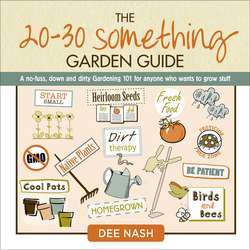Читать книгу The 20-30 Something Garden Guide - Dee Nash - Страница 10
На сайте Литреса книга снята с продажи.
YOUR GARDEN TOOLBOX
ОглавлениеLET’S TALK TOOLS. Everyone has a garden toolbox, and everyone’s is different. This is mine. As I moved from an urban balcony full of containers to a small suburban yard and then to a larger property, my toolbox changed some, but not as much as you might think.
One of the first things you’ll probably need is a hand weeder. You can pull most weeds from containers by hand, but once you move to open beds and borders, you will have more weeds with tougher constitutions. Most weeds come from seeds deposited by birds or are blown in from other locations. You’ll also want trowels to transplant seedlings, among other tools. Now you need something to tote your stuff.
Garden tools are just like cutlery and other kitchen tools; although cheap ones work for a while, you’ll eventually want to invest in something better. Don’t waste your time on plastic garden tools, unless you’re doing container gardening. They won’t hold up under normal conditions. I buy good kitchen and garden tools because I use them every day. As a result, I rarely have to replace anything. So, while my toolbox isn’t cheap, it holds good tools (some of which were received as great gifts).
FIVE GALLON BUCKETS are the best tool for toting in the garden. They are also great to drag behind as I weed.
GARDEN BUCKET CADDY. This type with pockets on the outside of the bucket leaves more room to carry things on the inside, like granular organic fertilizer and larger hand tools.
HAND WEEDER. My favorite is a Dutch hand hoe by DeWit Tools. It comes both left and right handed. CobraHead also makes a great weeder that I use to remove Bermuda grass from sidewalks.
GARDEN GLOVES. Different gloves work for different jobs. Thin Nitrile gloves, cheap and washable, are perfect in the summer and for jobs other than tending prickly roses. I usually don’t buy leather gloves because they get dirty and aren’t washable. If you can keep yourself from getting dirty while gardening, I’d like to know your secret!
BYPASS PRUNERS AND SNIPS. Even if you only grow vegetables, you’ll still need to cut plants back occasionally (like tomatoes). Sharp pruners keep you from breaking your plant. Fiskars PowerGear line of pruners and loppers are my favorites. I also like the super sharp Corona ComfortGEL Floral Snips FS 3204.
GARDEN SCISSORS. If you grow herbs, especially perennial ones, you will need scissors to cut back and deadhead. Fiskars makes good garden scissors.
TROWELS. I like trowels with a thin and sharp edge because they slice through the soil easier. Larger trowels are great for transplanting because they quickly make a perfectly sized hole for a four-inch pot. I have three trowels in my bucket: a Radius Garden ergonomic aluminum hand trowel, a Bond 1906 soil scoop that has a gel grip handle, and a bulb planting trowel.
RUBBER COATED PLANT TIES. It was a happy day when I discovered plant wire that was coated with rubber. It’s easy to cut and then bend into shape, and it holds plants gently.
PLANT TAGS. I either buy some at the beginning of the season, or I cut up old mini-blinds and use them for plant tags.
SHARPIE OR PAINT PEN. You always need something to tag your seeds after planting. I promise you won’t remember what you planted.
WATERING CAN/HOSE AND HOSE END SPRAYER (NOZZLE). You may also need a small sprayer for manure teas and other organic fungicides and sprays.
WATERPROOF NOTEBOOK. Developed for field studies, Rite in the Rain® spiral notebooks are great for recording when seeds are sown and other observations. An all-weather pen or pencil writes great on them.
Other tools you may need, but aren’t on the essential list:
HOE.
LEAF RAKE.
SHOVEL OR SPADE.
LAWN MOWER.
